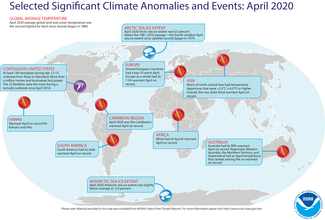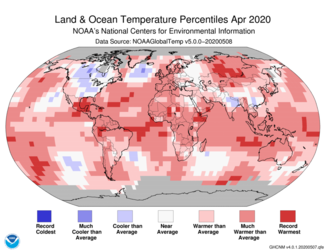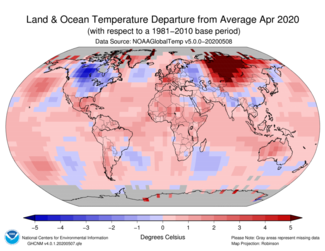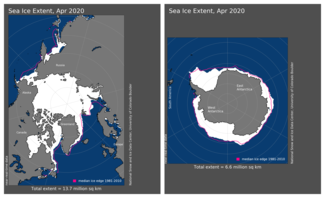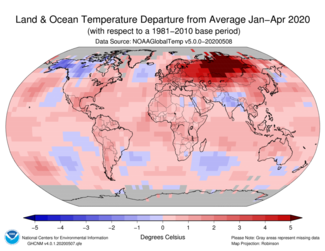Second warmest April on record

The April 2020 globally averaged land and ocean surface temperature departure from average was the second highest for the month in the 141-year NOAA global temperature dataset record, which dates back to 1880.
This monthly summary, developed by scientists at NOAA National Centers for Environmental Information, is part of the suite of climate services NOAA provides to government, business, academia and the public to support informed decision-making.
Temperature
The April 2020 global land and ocean surface temperature was 1.91°F (1.06°C) above the 20th-century average of 56.7°F (13.7°C). This was the second highest April temperature in the 141-year record. Only April 2016 was warmer at +2.03°F (+1.13°C).
-
April 2020 marked the 44th consecutive April and the 424th consecutive month with temperatures, at least nominally, above the 20th-century average.
-
The eight warmest Aprils have occurred since 2010. April 2016 and 2020 were the only Aprils that had a global land and ocean surface temperature departure above 1.8°F (1.0°C). The April 2020 value is also tied with December 2019 as the 11th highest monthly temperature departure in the 1,684-monthly record.
-
The most notable warm April temperature departures were observed across much of northern Asia where temperatures were 7.2°F (4.0°C) above average or higher. Other notable warm areas include western Australia, central Europe, the Gulf of Mexico, the Labrador and Bering seas, and across parts of the northern and southern Pacific Ocean and Antarctica, where temperature departures were at least +3.6°F (+2.0°C). Meanwhile, the most notable cool temperature departures of −3.6°F (−2.0°C) or cooler were present across much of Canada and the eastern contiguous U.S.
-
The Caribbean region and the Gulf of Mexico had their warmest April since records began in 1910. South America, Africa, Asia and Oceania had an April temperature that ranked among the sixth highest since continental records began in 1910.
The global ocean surface temperature during April 2020 was 1.49°F (0.83°C) above the 20th century average of 60.9°F (16.0°C) and was the highest April temperature since global records began in 1880. This value surpassed the now second-warmest April set in 2016 by 0.04°F (0.02°C). The eight highest April global ocean temperature departures have occurred since 2010. The April 2020 global ocean temperature departure tied with September 2015, February 2016 and July 2019 as the seventh highest monthly temperature departure in the 1,684-monthly record.
Sea Ice and Snow Cover
Arctic sea ice extent for April 2020 was 371,000 square miles (6.5 percent) below the 1981–2010 average and the fourth smallest April extent in the 42-year record, according to analysis by the National Snow and Ice Data Center (NSIDC) using data from NOAA and NASA. According to the sea ice regional analysis, the Baffin Bay, the Bering Sea, and the Sea of Okhotsk had a sea ice extent that ranked among the three smallest on record for April.
Antarctic sea ice extent during April 2020 was 81,100 square miles, or 3.0%, below the 1981–2010 average. According to the NSIDC, sea ice extent was slightly below average in the Ross Sea, as well as parts of the Weddell Sea.
According to data from NOAA and analyzed by the Rutgers Global Snow Lab, the Northern Hemisphere snow cover extent during April was 420,000 square miles below the 1981–2010 average and the 13th smallest April snow cover extent in the 54-year period of record. The North American snow cover extent was the 14th largest, while Eurasia had its third smallest April snow cover extent on record.
January–April 2020
The year-to-date global land and ocean surface temperature was also the second highest in the 141-year record at 2.05°F (1.14°C) above the 20th-century average of 54.8°F (12.6°C). This value is only 0.13°F (0.07°C) less than the record set in 2016.
-
Both the Northern and Southern hemispheres had their second warmest January-April period since global records began in 1880, behind the record set in 2016.
-
Europe and Asia had their warmest January-April period on record. The Caribbean region and South America had their second highest January–April temperature departure from average on record.
-
The first four months of the year had warmer-than-average conditions across much of the globe; however, the most notable warm January-April temperature departures were observed across much of central and eastern Europe and northern Asia, where temperatures were 5.4°F (3.0°C) above average or higher. Meanwhile, the most notable cool temperature departures of −2.7°F (−1.5°C) or cooler were present across Alaska and western parts of Canada.
-
Record warm January-April temperatures were present across parts of Mexico, Central America, the Gulf of Mexico, South America, the Atlantic Ocean, Europe, Asia, and across parts of the Pacific and southern Indian oceans. No land or ocean areas had record cold January-April temperatures.
-
According to a statistical analysis done by NCEI scientists, the year 2020 is very likely to rank among the four warmest years on record.
For a more complete summary of climate conditions and events, see our April 2020 Global Climate Report.

